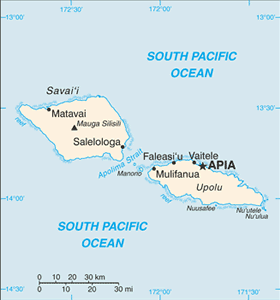The Geography of Samoa
The Geography of Samoa
Samoan Geography
Location: Oceania, group of islands in the South Pacific Ocean, about half way between Hawaii and New Zealand
Geographic coordinates: 13 35 S, 172 20 W
Map references: Oceania
Area: total: 2,944 sq km land: 2,934 sq km water: 10 sq km
Area - comparative: slightly smaller than Rhode Island
Land boundaries: 0 km
Coastline: 403 km
Maritime claims: territorial sea: 12 nm contiguous zone: 24 nm exclusive economic zone: 200 nm
Climate: tropical; rainy season (November to April), dry season (May to October)
Terrain: two main islands (Savaii, Upolu) and several smaller islands and uninhabited islets; narrow coastal plain with volcanic, rocky, rugged mountains in interior
Elevation extremes: lowest point: Pacific Ocean 0 m highest point: Mauga Silisili (Savaii) 1,857 m
Natural resources: hardwood forests, fish, hydropower
Land use: arable land: 21.13% permanent crops: 24.3% other: 54.57% (2005)
Irrigated land: NA
Natural hazards: occasional typhoons; active volcanism
Environment - current issues: soil erosion, deforestation, invasive species, overfishing
Environment - international agreements: party to: Biodiversity, Climate Change, Climate Change-Kyoto Protocol, Desertification, Hazardous Wastes, Law of the Sea, Ozone Layer Protection, Ship Pollution, Wetlands signed, but not ratified: none of the selected agreements
Geography - note: occupies an almost central position within Polynesia


